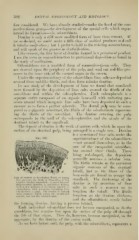Page 582 - My FlipBook
P. 582
592 DENTAL EMBRYOLOGY AND HISTOLOGY
fore considered. A\'e have already studied—under the head of the con-
nective-tissue grou])—the development of the special cells Mhich super-
intend its formation—viz. odontoblasts.
Dentine is only a still more moditied form of bone than cement. If
we so desired, we could make a fifth class of ossified products and call
it tubular ossification ; but I prefer to hold to the existing nomenclature,
and will speak of the process as dentinification.
Ijike cement, the iirst layer of dentine formed is a jiennaiicnt product.
I use the term in contradistinction to provisional deposition as found in
the study of ossification.
Odontoblasts are a modified form of connective-tissue cells. They
are situated upon the periphery of the pulp, and send out rod-like pro-
cesses to the inner side of the enamel organ in the crown.
Under the superintendency of the odontoblasts lime salts are deposited
around these rod-like fibrils, and thus form tubular dentine.
In our studv of the development of bone we found that canaliculi
were formed by the deposition of lime salts around the fibrils of the
osteoblasts and within the calcospherules. Each calcospherule is a
separate entity composed of an organic bone-cell with radiating pro-
cesses around which inorganic lime salts have been deposited in such a
manner as to form a perfect spherule. The dental pulp may be com-
pared to a gigantic osteoblast, the fibrils of the odontoblasts represent-
ing the fibrils of the osteoblast. The dentine covering the pulp
corresponds to the wall of the calcospherules, and the canals of the
dentinal tubvdi to the canaliculi.
The de})osit of dentine is the work of mature cells which lie upon the
surface of" the dentinal pulj), being arranged in a single row. Dentine
is a secretiim of lime salts under the
Fig. 330. superintendency of the odontoblasts
—not around themselves, as in the
case of the encapsuled osteoblast,
but around their fibrils. These
being rod-sha])e(l, the deposition
naturally assumes a tubular fi>rm.
The fibrils remain as the persistent
iji^'*'^LJt^Jf^^:^J',^3fv^^|f organic contents of the dentinal
^ -mi^B^^Allk-'*m'^-'
Part of Section of developing Tootli of youii};
l!;it, sliowinji tiie Mode of Iieposilion (if the canaliculi. The thickening of the
Dentine (liifihly magnified): n, outer layer of dentine by accretion of lime
fully-calcified dentine; li, uncalcified niatiix is
with a few nodules of calcareous matter; <; salts in such a manner as to
(xlontoMasts with pruccsscs extendiof^ into
the dentine; with carmine, which ciijors the uncalcified
matrix, Init not the calcified part. lengthen as the dentine thickens,
and the odontoblasts recede before
tlie finning dentine, leaving a process behind.
Each individual (tdontoblast does not become encapsuled, as do the
osteol)lasts, but remains free upon the surface of the j)ulp all through
the life of that organ. They do, however, become encapsuled, in the
aggregate, by the dentine of the entire tooth.
.
As we have before said, the pulp,- with the odontoblasts, represents a


